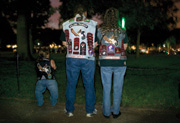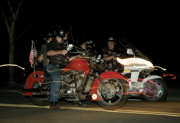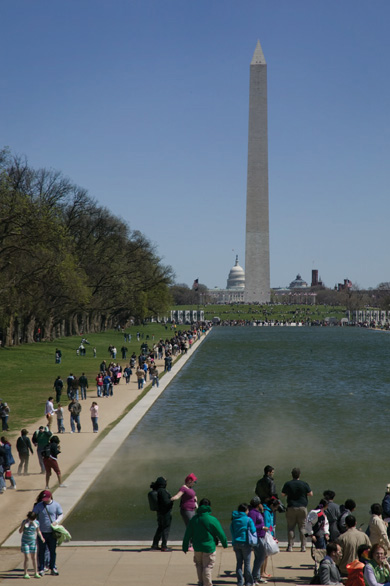
The Washington Monument and the Reflecting Pool.
The myriad buildings that constitute the governmental heart of the United States are arranged primarily and artistically around the National Mall, the architectural focus of Washington, DC. These buildings take inspiration from both modern and classical schools, and the spacious layout of the city center allows for ample opportunity to capture their finest aspects. Throughout the remainder of the city you will find a plethora of fine architecture reflecting such a diversity of influences that your memory card will be bursting at the seams!
DC also presents a feast of commemoration in the form of dramatic and eye-catching sculpture and statuary. Bronze is the frequent medium of choice, and photographic opportunities abound throughout the city. The good and great of the political, military, and scientific worlds vie for attention with remembrances of seminal events in our nation’s history. You will not run short of subjects in this field.
Unlike most urban centers, Washington, DC is, for the most part, spacious and harmoniously arranged, so finding a vantage point with an appealing view toward your edifice or memorial of choice is not too difficult a task. The major, and I mean major, obstacle to acquiring a professional-looking photograph of DC’s monuments is the constant crowds. Each year, some 700,000 tourists descend upon the Lincoln Memorial alone, with most of this veneration occurring during normal business hours, when you, too, are most likely to be shooting! Professional photographers overcome this by working at odd hours and being creative in their approach. With a modicum of forethought and ingenuity, you, too, can come home from your trip with lovely photographs and accompanying tales of achievement that you will be proud to display.
A medium focal length lens is appropriate for the majority of architectural shooting situations you will encounter in DC, since there is often no dearth of space between you and your subject. You can capture well-composed shots of most sculptures and memorials with a 35mm to 70mm lens. There are exceptions, of course. I find that a wide PC (perspective control) lens is almost invaluable when photographing broad and tall structures, such as the National Cathedral, where I used a 24mm PC lens. This lens behaves somewhat like a view camera, with manually controlled vertical and horizontal shifts that prevent the converging lines that result from pointing your camera up at a tall building. The PC lens does require a bit of practice to use, but it is a fantastic tool that will allow you to keep the sides of buildings and other vertical axes parallel in your photograph.
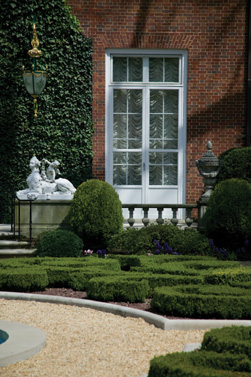
An architectural and garden tableau of the Hillwood Estate.
There are situations, on the other hand, that will require a longer focal length lens to achieve the look that you are searching for. For some shots of the Capitol building, I used a 135mm focal length, and at the Lincoln Memorial I was able to pull the 300mm lens out of my bag. Whenever possible, use your tripod and bubble level to ensure that both horizontal and vertical axes are straight.
Shooting the famous monuments in the early morning hours or after the sun has set will greatly increase your chances of having a crowd-free sight line. Often, the light at dawn can be pale pink and glorious and will wrap the city’s white marble monuments in a delicate glow. A deep blue evening sky and the night’s cloak of darkness do much to either disguise the crowds that may be present at your chosen shooting location or possibly discourage them from visiting at all. During the summer months and many spring weeks, the popular tourist attractions are literally swarming with families and school-age children— you will have to plan your shoot list accordingly or work the throngs into your photo to lend a sense of scale and in turn add a touch of life and humanity. I also find that including plant life—a tracery of unadorned branches in the winter and spring or a lush, leafy framework in summer—adds a real sense of place to a photograph and can soften the sometimes harsh lines of stony structures.
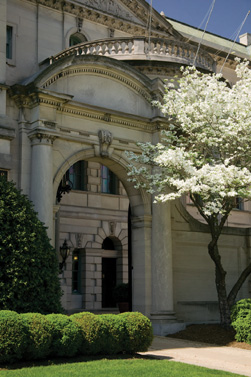
The entry arch of the Cincinnati Club on Embassy Row.
The National Cemetery, located in Arlington, Virginia, is the last resting place for members of the armed services fallen in each of the nation’s wars and, among others, explorers, historical figures, and justices of the Supreme Court. Arlington also is the final home for two of our nation’s presidents. One cannot help but feel moved by a visit to the cemetery. The vast yet orderly sea of small, plain gravestones is a vivid testament to the dedication to a cause of those who rest within.
The site was designated as an official military cemetery in 1864. More than 300,000 people are buried here, with an average of 28 additional funerals each weekday.
The Memorial Amphitheater near the center of the cemetery is the home of the Tomb of the Unknowns, where unknown American service members from World War I, World War II, the Korean War, and the Vietnam War are interred. This site has also hosted the state funerals of many famous Americans, such as General of the Armies John J. “Black Jack” Pershing, as well as annual Memorial Day and Veterans Day ceremonies. The amphitheater is constructed of white Danby marble from Vermont and presents many striking views.
Wherever you point your camera in the National Cemetery, you likely will have before you an arrangement of hundreds of gravestones, the linear placement of which makes for solid and organized compositions. You must take care, however, to place the foreground stone in a balanced juxtaposition against those behind and also to position yourself so that you can accentuate the long, straight avenues of grass between the markers. This sense of infinite acreage lends great emotion to the photograph.
I searched for a gravestone with a beautiful diagonal shadow falling on it from the branch of a tree above. This shadow and the dappled light falling through the leaves above are evidence of my use of chiaroscuro. This technique is particularly helpful here to maintain some nice tone in the foreground stones, which would otherwise be a stark, alarming, and toneless white. This view of the gravestones was taken in Section 38, at the corner of Schley Road.
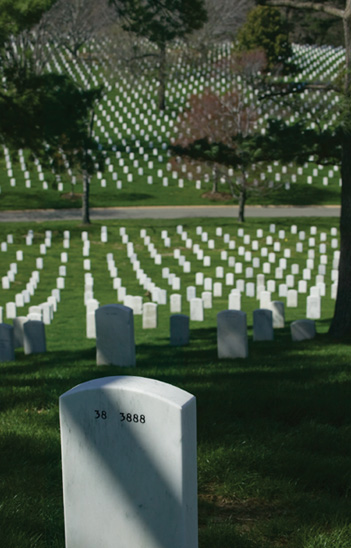
Focal length 70mm; ISO 100; aperture f/10; shutter 1/400; April 3:47 p.m.
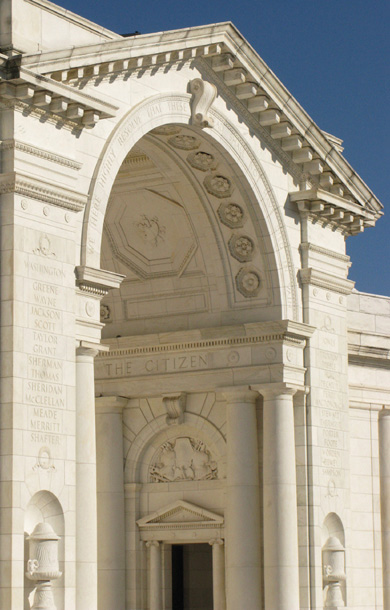
Focal length 22mm; ISO 100; aperture f/5.0; shutter speed 1/1250; April 5:14 p.m.
To render legibly the texture on the white marble of the Memorial Amphitheatre, the light in which you are shooting must rake across the face of the carvings. As the late afternoon sun beams from the west at a low angle, every minute detail of the bas-relief lettering, dentil moulding, carved rosettes, and even the shallow fluting of the urns is brought into stark contrast. The material of the amphitheatre itself acts as a gigantic and all-encompassing reflector card, bouncing light in all directions and reaching almost every nook and cranny of the structure with perfectly balanced fill light. This makes for a very wide and beautiful tonal range that the camera is able to capture—from a near bright white on the lightest faces of the bricks to a deep black inside the doorway, where light cannot bend the corner to illuminate. The deep blue of the afternoon sky to the east makes a vivid contrast against the pale stone—a study in blue and white!
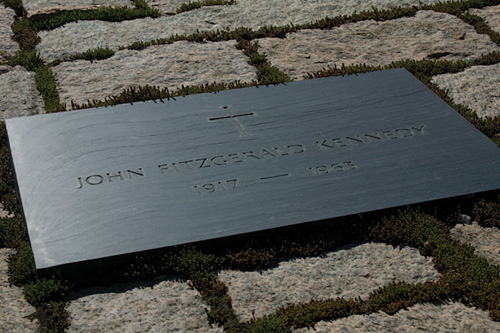
John F. Kennedy’s grave.
Arlington National Cemetery is located a short distance into Arlington on the southwest bank of the Potomac River. It is reached via the Arlington Memorial Bridge, which itself is to the southwest of the Lincoln Memorial and the Mall.
The Cemetery is open to the public at 8:00 a.m., 365 days a year. From April 1 to September 30, the cemetery closes at 7:00 p.m.; during the other six months, it closes at 5:00 p.m.
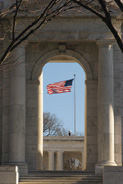
A side entrance to the Memorial Amphitheatre.
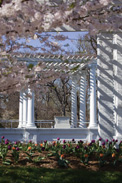
The gazebo at the hilltop of the cemetery.
Ample paid parking is available to visitors and is accessible from Memorial Drive. During all open hours, the Arlington National Cemetery Metro stop is regularly served by highspeed subway trains.
Topped by the Statue of Freedom, the U.S. Capitol building is the iconic architectural representation of the U.S. government. The imposing building houses Congress, the legislative branch of government, in both its Senate and House forms and sits majestically at one end of the Mall, facing away toward the Washington Monument and the Lincoln Memorial. The Capitol building, with its famous cast-iron dome and marble façade, probably tops the White House as the most defining of DC sights.
Construction of the Capitol was begun in 1793, and Congress took up residence in the (unfinished) building in 1800. The Supreme Court was located there in 1810. Despite being burned by the British in 1814, the main structure was completed in 1829. Another fire in 1851 (not the British this time) consumed the Library of Congress. Further extensions and enlargements continued throughout the nineteenth century, and modernization continues to date. Both the Supreme Court and the Library of Congress have, over the years, moved to their own buildings, leaving Congress to its own merry devices.
There are 360 degrees of vantage points from which to view the Capitol dome, yet certainly the most interesting shots happen when you place something else in the frame to add complexity, depth, and a sense of location to your image. This shot was taken from Independence Avenue, in front of the Rayburn House Office Building, which is directly south of the Capitol building. The day was a classically picture-perfect one, with the sky a deep blue and the air dry enough to keep the light crisp and clear. In May, the leaves on the trees are still new, and their emerald color, combined with the cerulean blue of the sky, the clean white of the dome, and the dark teal of the statue, contribute to the fresh and sparkling appearance of this image. I was happy to have a cloudless sky, because additional areas of white in the frame would have pulled attention away from the focus on the dome. As you compose your picture, remember to be conscious of where you place your main subject—you want the foliage to complement the subject, not overwhelm it. Try to avoid too much overlap or an excessively complicated pattern.
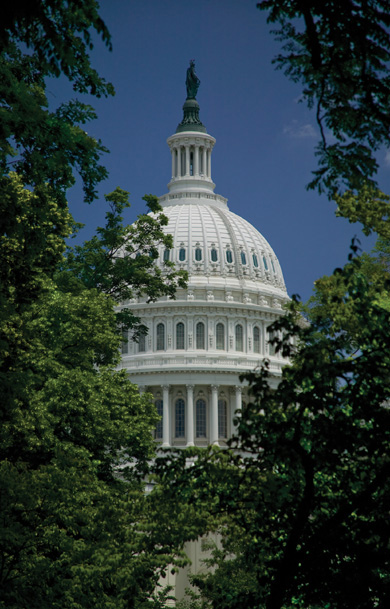
Focal length 135mm; ISO 100; aperture f/5.6; shutter speed 1/640; May 11:50 a.m.
To capture this scene of the Capitol building from a northwest vantage point, stand on 3rd Street NW, just a few steps south of Pennsylvania Avenue. In April, most of the trees in DC are not yet in full leaf, and the branches of this enormous and aged oak tree make a dramatic filigree through which to view the imposing dome. Aside from its majestic bearing, the overriding characteristic of the Capitol building is that its angles and sculpted details accept scrutiny under almost every lighting situation. What better model can one ask for?
On the day I shot this image, the rain had abated for only moments, and the sky was thick with clouds when I clicked the shutter, yet the white painted metal (yes, metal—not white marble or some other unusual stone) shows beautiful detail and tone. The soft light lends a painterly quality to the scene, as do the muted greens, browns, and pinks of the foreground flora. The two pedestrians at the bottom of the frame display accurately the scale and grandeur of the scene.
The Capitol building is located at the east end of the Mall, at the intersection of North/South Capitol and East Capitol Streets. The Capitol constitutes the center point of DC’s street numbering/lettering system, sitting at the adjacent corners of the NE, NW, SW, and SE quadrants of the city.
The Capitol is closest to the Capitol South Metro station, and walking in a northwest direction for less than half a mile will bring you to either the east or west frontage of the building.
If you are interested in touring the inside of the building, the Capitol Visitor Center is open to visitors from 8:30 a.m. to 4:30 p.m. Monday through Saturday, except for Thanksgiving Day, Christmas Day, New Year’s Day, and Inauguration Day. Tours of the U.S. Capitol are conducted from 8:50 a.m. to 3:20 p.m. Monday through Saturday.
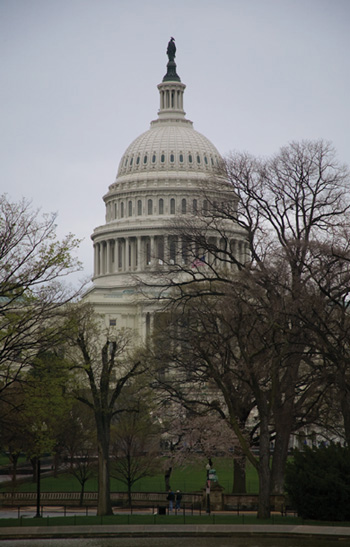
Focal length 125mm; ISO 100; aperture f/5.6; shutter speed 1/200; April 11:05 a.m.
Einstein was a scientist of supreme imagination and tenacity who reshaped the way in which we think about the structure of our universe. He is honored through this engaging statue showing him in relaxed pose, scribbling with pencil in his ever-present notebook, the map of the heavens spread at his feet. Unveiled in 1979, the statue presents an over-life-size tribute, lovingly burnished where the thousands of school-age visitors have clambered onto the great man’s lap. Located in the southwest corner of the grounds of the National Academy of Sciences, Einstein can be found in patient contemplation amongst elms and hollies.
I chose to do a close-up of Robert Berks’ marvelous Einstein 3D portrait, as this intimate view conveyed clearly the kind and droopy eyes; large, intelligent forehead; and tousled hairdo of this great scientist.
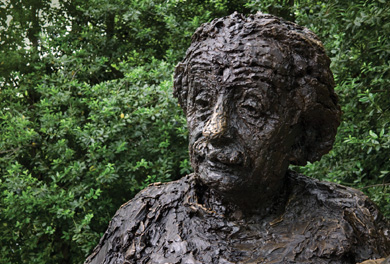
Focal length 70mm; ISO 100; aperture f/5; shutter speed 1/20; May 1:53 p.m.
Bright sun would be too high contrast for this sculpture—the shadows would be deep and black instead of soft and full of information and texture, as they are here. The wraparound quality of the diffused light also renders the highlights on the bronze in a broad and sculptural manner, which is much more appealing than the harsh, specular highlights that one would see under the light of a full sun. The variegated background of the leafy, green rhododendrons mirrors perfectly the rough and irregular surface of Einstein’s head and shoulders.
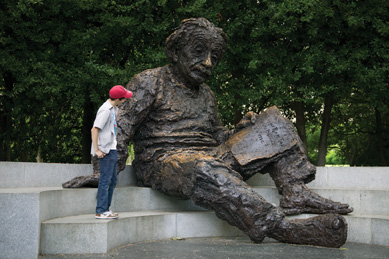
A fan of Einstein, studying his theorem.
I would usually search for a contrasting background when shooting a portrait, as this helps to focus your eye on the subject, but in this case, the complementary background is a stroke of luck. I love the way that Einstein blends into the background because the textures are so similar, but at the same time he is delineated by the difference in materials—hard metal versus the organic feel of the leaves. A bit of social creativity was required to capture the full shot of Albert sans crowd: “Okay. Everyone who is not a genius theoretical physicist, out of the shot!!” The tourists complied with my surprise request, and I was able to catch Einstein alone in his reverie with the universe.
A superb video is available on the sculptor’s website—robertberksstudios.com—that tells from soup to nuts the story of the constructions. It is a must-see.
The National Academy is located off Constitution Avenue between 21st and 22nd Streets. The closest Metro stop is Foggy Bottom, from which a walk of five blocks south and two east will bring you to the Academy. Einstein’s statue is positioned between the main building and Constitution Avenue, which itself flanks the Mall.
The Navy-Merchant Marine Memorial is one of the most striking and imaginative of DC monuments and commemorates sacrifice by sailors of the U.S. Navy and Merchant Marine during World War I. Known colloquially as Waves and Gulls, the piece, constructed in this case from aluminum, presents many angles and views for striking photography.
This monument is compositionally quite complex, and the ideal thing to do when you arrive is to spend a few minutes studying and searching for your favorite point of view. I chose a low angle to give the impression that the birds were soaring above me and to make the waves awe-inspiring as they seem to roil and heave toward the camera. I filled the frame edge to edge with the birds’ wings, which gives the photograph tension and creates strong and appealing negative spaces. My composition is triangular and balanced, and the viewer’s eye travels from the uppermost gull serving as the apex down and around to the waves in the foreground, where they swirl and crash against the edges of the frame.

A detail of the leading gull.
The water in this sculpture is rendered in a very illustrative style with decorative, almost beadlike sea foam, whereas the gulls are so lifelike you can almost hear their salty squeals. There are a multitude of whimsical, Art Nouveau details in every corner of the piece—spirals, shells, feathers, and scales abound. As with most metal sculptures, a cloudy or overcast sky is the perfect lighting situation in which to shoot this striking monument. Don’t forfeit a trip, however, if it is a sunny day— the matte aluminum surface is more forgiving in harsh light than one of polished bronze.
The memorial is located in Lady Bird Johnson Park on Columbia Island and is best approached by the walking/bike path that follows the southwest bank of the Potomac River from the Arlington Memorial Bridge toward the Pentagon. The Metro stop at the Arlington Cemetery is about a 10-minute walk to the memorial.

Focal length 28mm; ISO 100; aperture f/4; shutter speed 1/1000; May 9:14 a.m.
One might be fooled into believing that the only noteworthy buildings in the center of DC are the White House and the Capitol. Far from it! Throughout the area surrounding these famous sights, you can find a wealth of architecture from neoclassical government buildings, to dramatic monuments, to refined and stately family residences.
The majority of architectural interest in DC lies within the northwest quadrant of the city. It pays to become familiar with the layout of this area to maximize your photo opportunities. Streets running east to west are lettered consecutively, while streets running north to south are numbered. Streets running diagonally are named after states. The design was first outlined by L’Enfant in 1791, but the city really took its current shape following the work of the McMillan Commission in 1901, which led to the city’s current European-style grandeur. This plan led to the clearing of previous slum dwellings and gave rise specifically to the Mall and its monuments and to Union Station.
The Blair Lee House was built in 1824 for Dr. Joseph Lovell, first Surgeon General of the United States and original organizer of the Army Corps of Engineers. This National Historic Landmark has served since 1942 as the official guest house of the President of the United States. It is an excellent example of Washington residential architecture.
Nestled into the northwest corner of the frenetic square surrounding the White House, the façade of the Blair Lee House is pictured here in a calm and peaceful still life. The Federal style architecture of the building lends itself to a geometric, almost Mondrian-like composition, the effect of which is deepened by the patchwork sidewalk at the bottom of the frame.
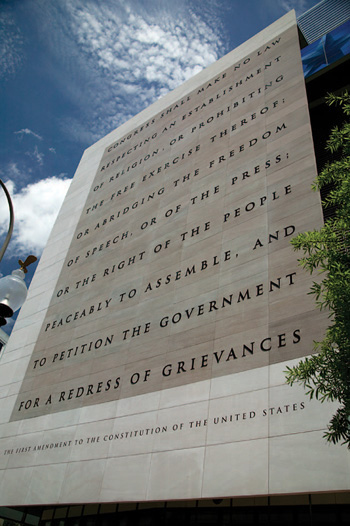
The front façade of the Newseum.
I shot from directly opposite the house, elevated by a stone curb to ensure that my camera lens would truly be centered on my subject and that my vertical lines would be straight. Accurate right angles are a vital aspect in the structure of this image, as is the soft light from an overcast sky. Harsh shadows would disturb the flat, cubist effect I have captured here. I took several frames, moving the camera slightly up, down, and laterally, until I settled on a pleasing composition of lines and rectangles. You can see how the Washingtonian’s penchant for well-manicured shrubs can add to the beauty of a photograph! You must wait patiently, also, so that the pedestrians in this busy area are out of the frame.
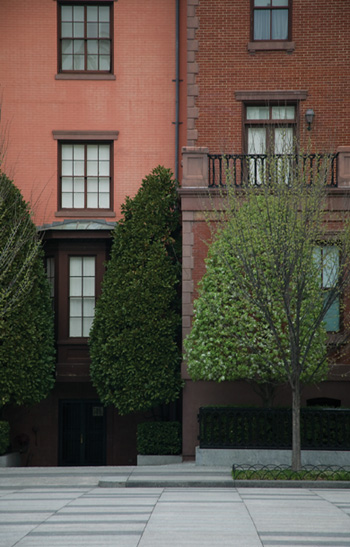
Focal length 110mm; ISO 100; aperture f/5.6; shutter speed 1/80; April 2:44 p.m.
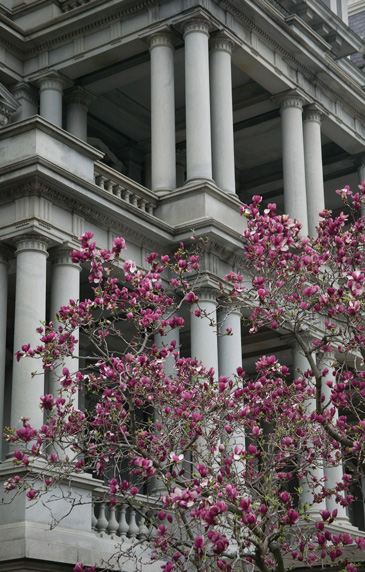
Focal length 80mm; ISO 100; aperture f/5.6; shutter speed 1/50; April 2:50 p.m.
On the west side of the White House lies the Executive Building. These offices are the workplace for the majority of White House staff. This French Second Empire–style structure was once referred to as “America’s greatest monstrosity” by Harry S. Truman, and the building presents much flamboyant yet admirable detail for the keen eye.
This shot is an architectural study in gray, rose, and white and once more shows my fondness for juxtaposing organic elements with rigid structural ones. The day again was overcast, which creates a full, luscious tonal range in the image. If this shot had been taken under full sun, the shadow areas would be deep black, and the gentle tonal transitions in the gray stone would be lost.
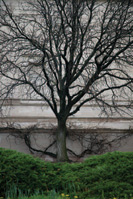
A winter tree on the side of the National Gallery.
The tracery of branches and magnolia blossoms separates beautifully in this situation from the soft gray under layer, whereas if the light had been harsh, the overlay effect of the tree would have been too complex and jarring to the eye. Stand on the corner of E Street NW and 17th Street and point your camera up to capture the corner of the building behind this enormous magnolia. Of course, depending on the time of year that you are there, you will have blossoms, leaves, or bare branches before you. Foot traffic poses no problem here, since you are cropping well above the level of the sidewalk.
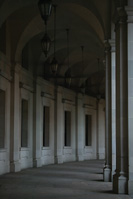
Archways at the Environmental Protection Agency building.
All five Metro lines run through the White House/Capitol area and can be used to access any part of the surroundings of the Mall. The Mall itself is 1.5 miles in length and can be explored on foot, but in summer be conscious of the heat and humidity when planning your itinerary.
The Farragut North and Farragut West stations lie about 500 yards to the north and northwest, respectively, of the Executive Building. Walk south on 17th Street to find the Executive Building opposite F Street.
The Blair Lee House is located on Pennsylvania Avenue, just to the north of the Executive Building. It is not open to the public.
Prepare your equipment and yourself for a trip to the architectural zoo! Imagine a closely packed and orderly array of exhibits arranged for simple access for the visitor. Also imagine that each exhibit reflects both the culture and prosperity of its country of origin and a process of evolution from earlier displays. This is Embassy Row, and entrance to this architectural menagerie is free! More than 60 of the foreign embassies located in Washington, DC are situated on and around Massachusetts Avenue NW. Walk the two-mile stretch of Embassy Row and bring home a record of how each nation uniquely presents itself in our capital.
The tone for this section of DC was set in the late nineteenth and early twentieth centuries by the construction of many fine homes by the social and political elites. Known as Millionaires’ Row, the street held on to that status until the Great Depression. Starting in 1929, with the newly constructed British Embassy (built to reflect an English country home, which now serves as the British Ambassador’s residence), the Row progressively developed its current character through a process of modification, addition, and new building. Architectural styles and accompanying monuments can be found that intriguingly reflect the nationality of each embassy.
Set before you on Embassy Row is a panoply of architectural styles, and your first decision when shooting is what sort of photograph you would like to bring home. Modern and spare? Baroque and curvy? To satisfy the first choice, I meandered up the hill to #3301 Massachusetts Avenue for the Finnish Embassy. This building is a splendid representation of Finnish values— from use of natural light, evidenced by the generous use of glass blocks, to the Finns’ yen for a direct connection with nature. (The façade has a healthy covering of vines and ivy, and only five trees were cut down to build the structure.)

The front gate of the Embassy of Indonesia.
Stand on the sidewalk across the wide expanse of the avenue and situate your camera so that it is directly in front of the Embassy. With a medium telephoto, you can fill the frame with the building and crop out the parking area in the front. This focal length will also allow you to maintain the straight lines and right angles that are crucial to the impact of this photo. The façade is quite flat, so you do not need great depth of field. Try to shoot on a partly cloudy or sunny day. If the sky is overcast, the light will be too soft, and you will not have enough contrast to bring out the beautiful details in the material of this structure.
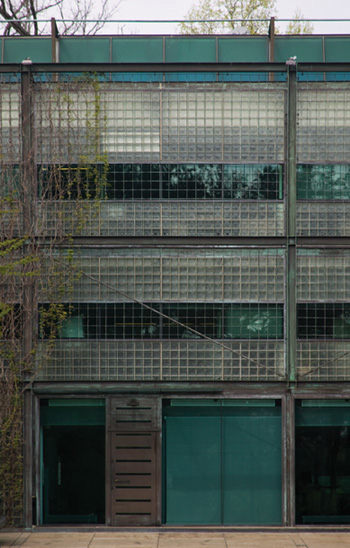
Focal length 130mm; ISO 100; aperture f/7.1; shutter speed 1/60; April 2:39 p.m.
For a more romantic visual experience, walk a few blocks down the hill of Massachusetts Avenue to #2440, the Mexican Embassy. This building is designed in a classic Hacienda style, and as you walk by, you can almost hear the mariachis as you are transported south of the border just for a few moments. Try to photograph here on a fully sunny day, since this sharp and direct light creates beautiful negative spaces under the arches and between the columns of the peach-toned adobe walls. The contrasty light only serves to further the illusion of Mexico in DC.
I stood in the driveway just outside of the embassy and moved left and right until the upper curves of the stairwell arches and its windows were framed perfectly by the large opening of the main entrance. I kept the Mexican emblem above the arch in its entirety and purposefully arranged the quarter circle of shadow at the bottom-left edge of the frame.
The success of this type of photograph relies heavily on your sense of composition, so be very careful and deliberate as you are placing the shapes within your frame. If you feel hesitant or unsure of how exactly to compose the shot, take several pictures, moving left and right and up and down to place the shapes in several different arrangements. Later, when editing at your computer, you can find the composition that most appeals to you.
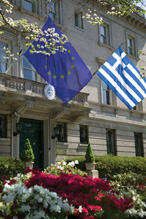
The façade of the Embassy of Greece.
Embassy Row is readily reached via the Metro, taking the Red Line in the direction of Shady Grove and alighting at Dupont Circle. Most of the embassies lie to the northwest, although several also are located to the southeast. If you’re driving, look for parking along the side streets off Massachusetts Avenue.
The Mexican Embassy is located at 2440 Massachusetts Ave. NW, 500 yards northwest along Massachusetts Avenue from Dupont Circle. (If you reach Sheridan Circle you have gone too far.)
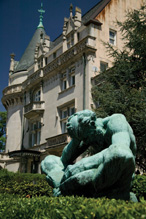
A statue of St. Jerome the Priest in front of the Croatian Embassy.
The Finnish Embassy is located at 3301 Massachusetts Ave. NW, 1 1/4 miles northwest from Dupont Circle along Massachusetts Avenue, just before you reach 34th Street. This latter distance can be covered using one of the Metropolitan Area Transit buses (N2 or N4) for a nominal charge, but if you are up for the walk, you will be able to study a fascinating array of embassy architecture for the complete length of your exertion.
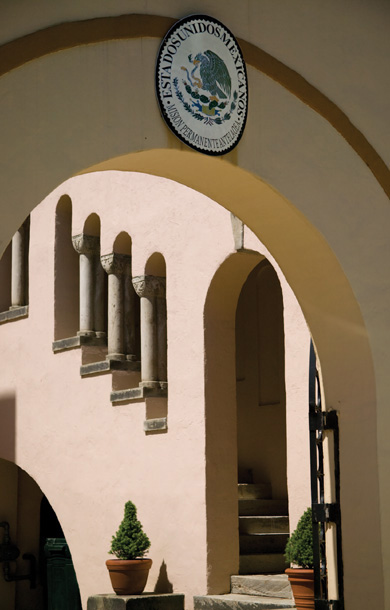
Focal length 75mm; ISO 100; aperture f/5.6; shutter speed 1/800; April 10:43 a.m.
The Georgian architectural style dominated British and American construction during the 18th century. Named after the Kings George who ruled Britain and the colonies during that time, the design prevailed throughout Britain and the developing province. The style is recognizable for its simple one- or two-story symmetrical box design. A panel front door is centered and flanked by multi-pane windows, usually five across. A decorative cornice is usually included to lighten the initial severity of the design.
Alexandria is located five miles to the south of DC on the west bank of the Potomac. The town was instituted in 1748, and these historical roots define the architectural style that characterizes its streets. In 1791, George Washington included Alexandria in the area to be known as the District of Columbia, and although the town represents a DC outpost, it is a thriving and fascinating part of the community.
The Old Town section, in the eastern and southeastern areas of Alexandria, is the oldest part of the city and is designated a historic district. Old Town is chiefly known for its townhouses, art galleries, antique shops, and restaurants. The rejuvenated waterfront harkens back to the town’s early days as a thriving colonial port. Visit Old Town Alexandria and seek out its classic Georgian Colonial architecture.
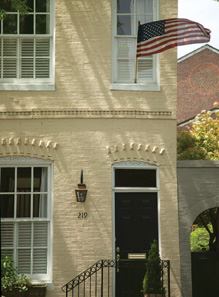
Interesting brick details on a colonial home.
This home, the Carlyle, holds the honor of being the only stone, 18th-century Palladian-style house in Alexandria, Virginia. Its plain and geometric façade make a simple and direct photographic statement if framed well. I stood on the sidewalk just to the right of the gate and the arch of the brick wall. Rather than take only a flat, frontal shot of the home, I opted to include the soft curve of the brick wall at the bottom of my frame. This adds a bit of texture and depth, and I like the contrast of the smooth curve of the wall to the right angles of the building. The spare and monotone quality of the house is furthered by the fact that it is slightly backlit, keeping any raking shadows off the façade. Be sure to have your lens as straight and centered to the house as possible. I actually stood on my camera case to elevate me slightly and keep the lines of the house from converging.
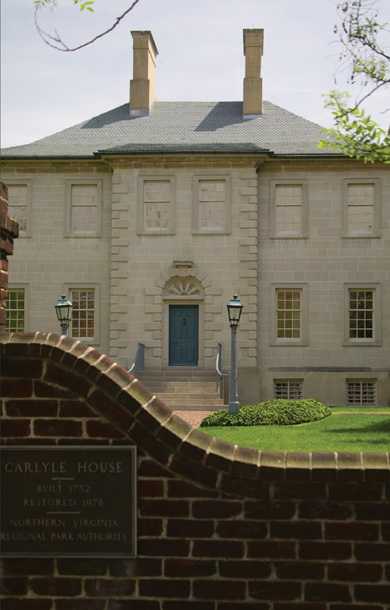
Focal length 47mm; ISO 100; aperture f/5.6; shutter speed 1/200; April 11:35 a.m.
This shot demonstrates not only a sample of classic colonial architecture, but also one of the very convenient lighting situations to be experienced in Old Town Alexandria. The majority of the residential streets are lined and sheltered by old and majestic trees, which makes for attractive shots even at the height of the day. The leaves and branches of the trees act as a living cuculoris and cast interesting and playful shadows on your subject matter. An added bonus to shooting around noon is that most pedestrians will be lunching, and your path of view will be clear. I prefer to avoid including people in this type of scene, because it is only without the modern touches of clothing and autos that you can truly convey a sense of historical authenticity. So, unlike most places and days, shoot away at noon and treat yourself to a well-deserved late lunch at any one of Old Town Alexandria’s great pubs.
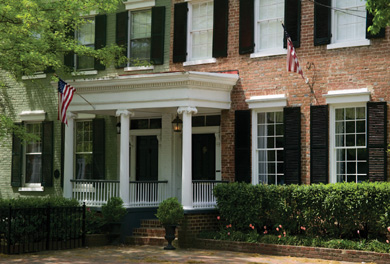
Focal length 75mm; ISO 100; aperture f/5.6; shutter speed 1/100; April 11:47 a.m.
Take the Blue or Yellow Line Metro to the King Street stop and either walk about 10 blocks to the east or take a DASH (Alexandria city) bus for a dollar to the historic area. To drive to Old Town, take the George Washington Memorial Parkway along the west bank of the Potomac to East King Street. There are parking meters on the street and plenty of parking garages in the area.
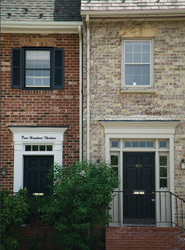
A portrait of contiguous brick colonial homes.
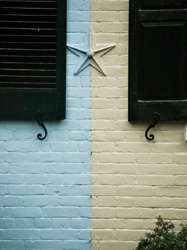
A period detail shared by two homes.
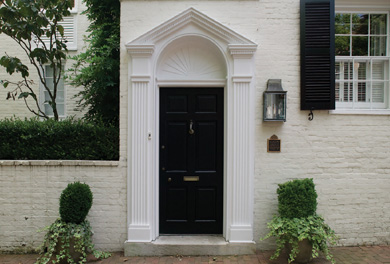
A Georgian door-surround in…Georgetown!
IN THIS TEMPLE |
AS IN THE HEARTS OF THE PEOPLE |
FOR WHOM HE SAVED THE UNION |
THE MEMORY OF ABRAHAM LINCOLN |
IS ENSHRINED FOREVER |
Etched high on the wall, these simple but compelling words ring out from this spectacular memorial to Abraham Lincoln. As President during one of the seminal events in the history of the United States, Lincoln is justly memorialized in this imposing white marble and limestone edifice, which stands proudly at one end of the Mall.
Construction was begun in 1914 and completed in 1922. The stately design is based on that of a classical Greek Doric temple. The imposing steps and columns first take the eye, but you are then drawn to the inner chamber, where Lincoln’s statue sits pensively looking out across the Reflecting Pool toward the Washington Monument. On the walls around the statue are chiseled the words of the Gettysburg Address and of Lincoln’s second inaugural address. As a truly fitting commemoration, it is no wonder that the Memorial receives millions of visitors every year.
The Lincoln Memorial may have millions of visitors each year, but on any given evening, you will probably only encounter thousands of them. A cloak of darkness works wonders in toning down brightly colored tees and baseball caps into one, dark, amorphous mass. I actually prefer this photo to a less peopled one. The dimmed throng with their colored camera flashes tells a story of how popular a place this really is.
For shots like this, when time of day is a crucial factor (I researched ahead the exact time for sunset), I like to arrive at least 30 minutes early to ensure that I will have time to handle any technical problems that may arise. I placed my camera and tripod at the farthest point in the plaza facing the Memorial and made sure that I was centered and squared in front of the Memorial. I use a ball head on my tripod, which makes tiny adjustments along any axis very simple to perform. After a couple of test shots, I was able to see on my viewing screen that the Memorial was straight in the frame.
The exposure compensation on my camera was set to –1.67, which gave me the overall dark image I was looking for and made certain that the brightly lit statue of Lincoln would not be overexposed. The shutter speed of almost a second allowed me to capture a few of the hundreds of flashes from the tourists’ cameras, and, to my happy surprise, I was also able to catch the colored light trails from one of the many jets that evening on its way to Reagan National Airport. I snapped quite a few exposures, but my favorites happened after the sun had set, when the luminance of the deep blue sky matched that of the spotlight on the pediment.
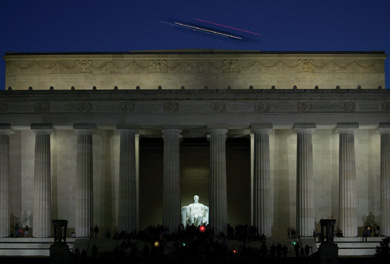
Focal length 70mm; ISO 100; aperture f/5.6; shutter speed 0.8 seconds; April 7:19 p.m.
Note
Nighttime and long exposures are greatly aided by the use of a cable release. It’s a tiny and weightless addition to your camera bag, yet it can be indispensable.

The exterior viewed from the south.
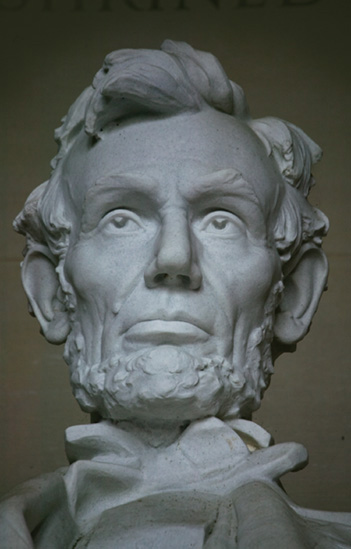
Focal length 300mm; ISO 100; aperture f/5.6; shutter speed 1/80; May 1:09 p.m.
One of the most alluring aspects of this Memorial is the stark contrast between the palatial and mathematical outer perimeter of the structure and the meditative, almost religious quality to the interior. Even when bustling with crowds, the area immediately surrounding Lincoln’s statue is hushed, and the reverence is palpable. Security is very strict and the no-tripod rule is strongly in effect, so I had to be mindful, even with my 300mm IS (image stabilization) lens to avoid camera shake. I kept my elbows close to my sides, held my breath when pressing the shutter, and took several frames of each view that I photographed. This ritual in itself makes shooting Lincoln’s hands and visage a devotional experience! The light in the interior is soft and enveloping and spreads beautifully over the creamy stone. I also love the quick falloff and how Lincoln’s head is rimmed in shadow.
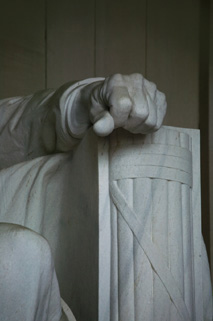
A meditative study of Lincoln’s left hand.
Note
Previously confined to only the professional market, IS, or image stabilization, is a technology that is now finding its way to the consumer. Image-stabilized cameras and lenses use very small gyroscopes to stabilize the equipment during exposure, resulting in sharper photographs with less motion blur from camera movement. This technology proves especially useful when shooting handheld with a long telephoto lens.
The Lincoln Memorial is sited at the western end of the Mall. The closest Metro station is Foggy Bottom on the Orange and Blue Lines. Turn south out of the station and enjoy the half-mile walk down 23rd Street through the campus of George Washington University and past the State Department. After crossing Constitution Avenue, you will take to the paths that meander through the Mall. Find your way to the front of the Memorial, which faces toward the Washington Monument and the Capitol to the east. The Lincoln Memorial is close to the Korean and Vietnam War Memorials, which you should also visit.
In this outer northwest section of Washington, DC lies the National Cathedral. The church is dedicated for national purposes and welcomes people of all faiths and perspectives. Though specifically Episcopal in denomination, the Cathedral has a broad mission acting as a national focal point, both religious and civic in nature. The calendar includes a full palette of services throughout the week and also organ recitals, art and architecture tours, lectures, and other educational opportunities. In addition, the Cathedral hosts events of major national significance, including Presidential Inaugural prayer services and funeral and memorial services for former Presidents.
Construction of the Cathedral was begun in 1907 and with the final completion in 1990 of the West Towers, it achieved the unusual distinction of being the most extended construction project in the history of Washington, DC. The American Gothic architectural style towers ornately above the surrounding suburban environment. More than 100 gargoyles, 200 stained glass windows, and nearly 300 angels adorn the structure, which presents multiple magnificent aspects.
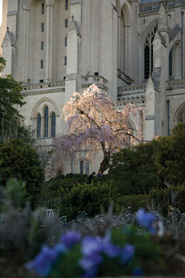
The cathedral shot from the herb garden.

One of the many striking stained glass windows.
Shooting a frontal portrait of the National Cathedral is a perfect opportunity to pull your wide-angle PC (perspective control) tilt-and-shift lens out of your gear bag. At the time of this writing, Canon has just come out with a 17mm PC beauty, but for this shot, the 24mm PC was sufficiently wide. There is quite a spacious park in front of the church, and by standing on the pathway that is at the farthest edge of the park, I was able to capture, even in landscape format, the top of the turrets and some passersby in front to show scale. I prefer a horizontal shot over a vertical one for this view, since the inclusion of air and scenery on either side does much to show the enormity of the cathedral. The jumble of leafless tree branches adds a haunting air, and the deep blue eastern sky of sundown is an appropriate and rich background.
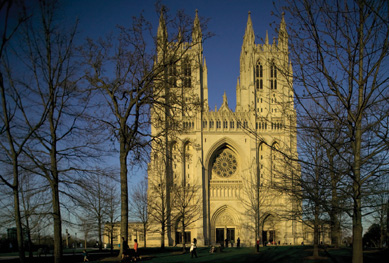
Focal length 24mm; ISO 100; aperture f/5.0; shutter speed 1/1250; April 6:02 p.m.
This shot is a superb example of how at the same location on the same day and only an hour apart, one can create a photo that is of an utterly different mood and theme. This is the view of the Cathedral as you crest the hill of Woodley Road, walking west. It was a beautiful, clear spring day, and the sun was low in the sky late in the afternoon, which gave depth and zing to every surface. As I came upon this view, with its tapestry of various textures and colors, I knelt low to frame the picture with branches from above and daffodils below. The wooden bench lends the scene a meditative quality and a vestige of human activity. Possibly someone was recently sitting on the bench reading and was whisked away up the stairs by churchly responsibilities. You can almost hear the staccato footsteps on the stone or the gentle rifling of pages by a breeze.
The National Cathedral is located in northwest DC, some four miles from the Capitol. It can be reached from Massachusetts Avenue—turn north onto Wisconsin Avenue where it crosses Massachusetts Avenue, and the Cathedral will be on your right after 200 yards. A visit to the cathedral can be combined with your visit to Embassy Row, the northern end of which is found back on Massachusetts Avenue.
Driving to the Cathedral is feasible—there are many side streets on which to park, but you will find much of the space taken by zoned residential parking. Use the Cathedral’s underground parking garage, which is accessed from Wisconsin Avenue just south of Woodley Road. A fee ranging from $4 to $16 is charged depending on day of the week and length of stay. Sundays are free of charge!
Alternatively, take the Red Line Metro to Cleveland Park and approach the Cathedral from the east. It is an eight-block walk from Cleveland Park to the Cathedral. On leaving the station, take Porter Street west, then turn left on 34th Street and right on Woodley Road. The Cathedral will be on your left. However you travel to the Cathedral, you will find it well worth the exertion.

View of a turret through the arches of the Women’s Transept.
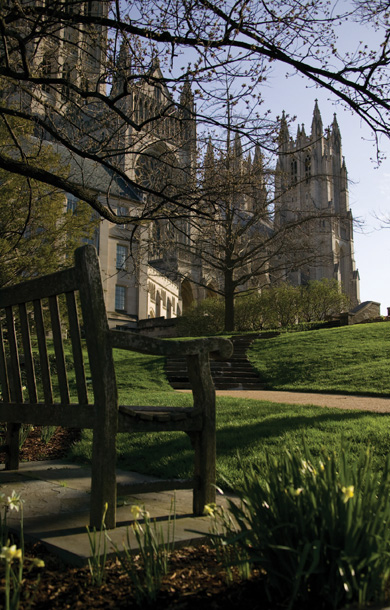
Focal length 35mm; ISO 100; aperture f/5.0; shutter speed 1/500; April 5:00 p.m.
As one of the more recent additions to the DC ranks, the U.S. Navy Memorial is constructed as an open environment in which to honor the dedication to duty of America’s sea services. Although such a memorial was envisioned in L’Enfant’s original plans for the city, it was only late into the twentieth century that such plans came to fruition. During the 1980s and in conjunction with the overarching Pennsylvania Avenue redevelopment program, the Memorial site was chosen at Market Square facing the National Archives. Construction was completed by 1987 when the site was dedicated as a continuing appreciation of the work and sacrifice of the U.S. Navy’s service personnel.
The design of the memorial is airy and spacious, featuring an open amphitheater. The floor of the space consists of a 100-foot-diameter map of the oceans of the world—“The Granite Sea.” Twenty-eight bronze bas-relief panels surround the southern hemisphere, depicting historic events, activities, and personnel of the Navy. These are offset by the centerpiece of the memorial—a statue of the Lone Sailor, standing resolutely on watch and representing the self-reliance and strength of character of the members of the force. The Memorial site is completed by the Naval Heritage Center, which houses the service records of more than 230,000 Navy personnel.
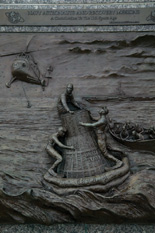
One of the bronze relief sculptures that encircle the plaza.
The Memorial Plaza balances somber respect for the personnel of the Navy with an outdoor public space for the use of the people of DC.
Understandably, when the subject of your photograph is a flag (or a sail or a windsock, for that matter!), it is by far best to photograph it on a dry, windy day, when the sky is an azure blue with white clouds. Spring in DC serves up many of these fresh, clear days, and the flag standards that flank the Naval Memorial, against this backdrop of a sky and clouds, make ideal maritime subjects.
I used a fast shutter speed to capture every whip and furl of the fabric, and the triangular shape of the flagpole makes for a solid and balanced composition. The low angle from which I photographed the flags lends a heroic aspect to an already patriotic scene, and the saturated and contrasty colors of these flags do more than just make pretty pictures—they are the five colors that can be readily distinguished at sea. Nautical flags (or international code flags) include 26 square flags that correspond to the letters of the alphabet. This photograph shows the message N-A-V-Y M-E-M-O-R-I-A-L topped by the red-and-white-striped Navy Jack flag.
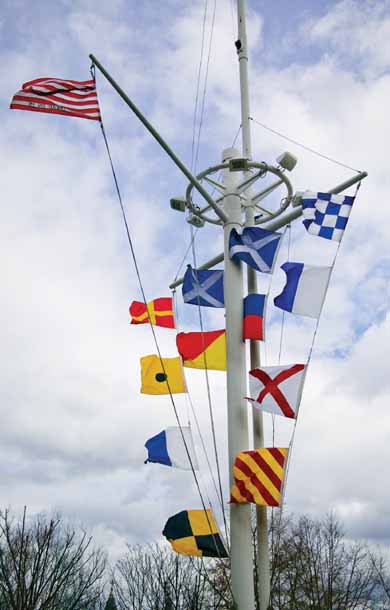
Focal length 50mm; ISO 100; aperture f/5.0; shutter speed 1/2500; April 2:45 p.m.
One of the really eye-catching characteristics of Washington, DC is the tableau of important and historical structures that exist as backdrops to quotidian cultural and sporting events. A rock band playing outdoors on a Saturday afternoon becomes a completely different visual experience when you find yourself composing the instruments and singers against the flags of the Navy Memorial and the columns and pediment of the National Archives building. This band, Gaslight Society, would, I am sure, have preferred a larger and more appreciative audience, but for me, from a photographic standpoint, the empty chairs make a simpler and more striking backdrop behind the lone guitar. I crouched low, right behind the band, and pointed my camera a little up to capture the Archives, and I was careful to center the neck of the guitar between the flagpoles.
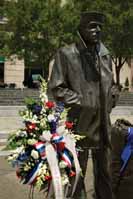
The bronze statue of the Lone Sailor.
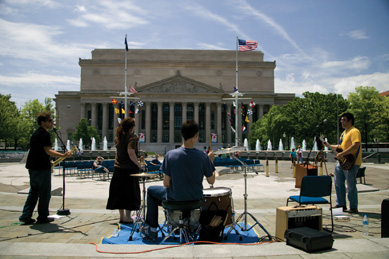
The band Gaslight Society playing at the Memorial.
The U.S. Navy Memorial is tucked between some of the major government buildings just to the north of the Mall. It is located between 7th and 9th Streets on Pennsylvania Avenue. It is most readily accessed from the Archives Metro Station on either the Green or Yellow Line. Exit the station and walk half a block north, turn left on Pennsylvania Avenue, and the Memorial plaza will be on your right.
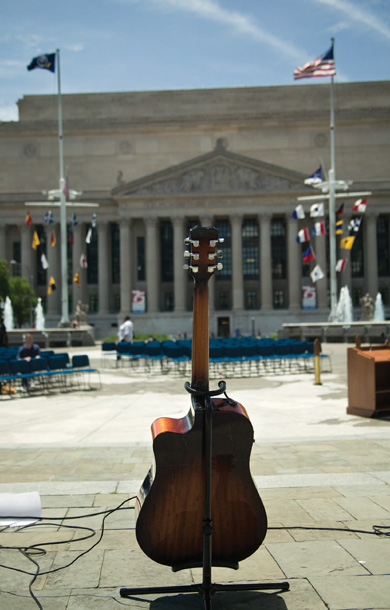
Focal length 47mm; ISO 100; aperture f/4.5; shutter speed 1/500; May 11:22 a.m.
In balancing and blending the need of society for order with the rights of individuals, the framers of the United States Constitution created three independent and coequal branches of government. The Supreme Court of the United States holds the position of primacy in the legal branch. The ultimate responsibility of the Supreme Court is emblazoned on the pediment of the Court building: “EQUAL JUSTICE UNDER LAW.” As the final arbiter of the law, the Court stands to ensure that all American people receive fair and equitable treatment under the Constitution.
Despite its major role in the nation’s government, the Supreme Court spent its first 146 years without a home of its own. Only in 1935 was the current building completed and occupied—the Court had previously shared space, mostly in the Capitol building. The white marble, neoclassical design speaks to democratic ideals, and its peak is embellished with a sculpted figure of Liberty flanked by strong guardians and sage advisers.
More than 10,000 petitions annually are filed with the Court for consideration by the Chief Justice and the eight Associate Justices and their staff. About 100 of these cases reach the stage of oral argument before the Justices.
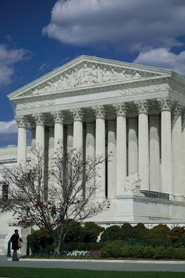
A view of the building from the southern approach.

Another composition of statue and building.
This kind of shot takes a sense of purpose and a bit of contemplation in order to achieve your desired composition and arrangement of people as props. I can’t tell you how many folks I saw walk quickly by the building, look to the right, and exclaim, “Oh, the Supreme Court building!” and snap off a rapid frame without even looking through the viewfinder. This is no way to capture a pleasing image—you have to take a breather to think a little bit about what you are actually putting into your frame.
To accentuate the enormity of the Supreme Court building, I purposefully included a few people at the front of the building. The edifice is so large that these folks almost look like toy figures, which is a nice effect. I stood on the sidewalk in front of the building, made sure that my horizon line was straight, and included a small bit of the left side to add depth and show the double columns. I waited patiently until the number of people on the stairs was just enough for effect but not too much for distraction, and then I pressed the shutter as the sun was emerging from a cloud to give me soft contrast that brings out all the carved relief.
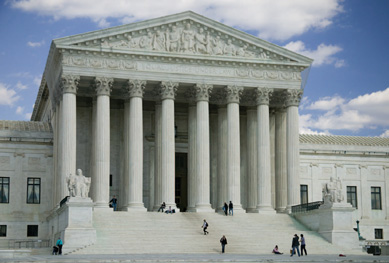
Focal length 65mm; ISO 100; aperture f/6.3; shutter speed 1/200; April 3:19 p.m.
This statue, Contemplation of Justice, makes a wonderful companion shot to the previous image of the Supreme Court building. There is a great deal of classic sculptural interest in this building, and closer-up detail shots such as this really help to give your viewer a broad overview of what you were experiencing.
This shot looks very much like a traditional portrait view of the statue. The curtain of fluted columns works beautifully as a consistently patterned background, showing a wide range of grays in what most people would probably describe as all-white columns. The three-quarter view of the figure conveys the depth and shape of the sculpture and the black grillwork adds nice contrast to the soft gray and white tones of the marble.
Make sure in a shot such as this that you compose with a straight horizon line—this does much to further the impression here of solidity and gravitas.
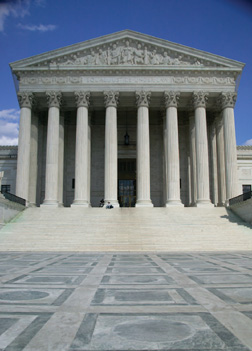
A full frontal view of the building with its large expanse of stone plaza.
The Supreme Court of the United States is located at One First Street, NE. It faces the U.S. Capitol and is adjacent to the Library of Congress.
The building can be reached using the Metro. The most convenient Metro stops are Capitol South on the Blue and Orange Lines (walk north for four blocks on First Street) and Union Station on the Red Line (a similar distance south on First Street).
Street parking near the Court is extremely limited.

Focal length 135mm; ISO 100: aperture f/6.3, shutter speed 1/400; April 3:20 p.m.
The White House is one of DC’s oldest and most renowned buildings. A “palace” for the President was included in L’Enfant’s original design for the city, and President Washington initiated construction in 1792. However, the first President to take up residence was President Adams in 1800. As the private home of Presidents, the building has been continually modified by the succession of residents, most notably by President Harry S. Truman, who completely renovated the interior. The building consists of 132 rooms on six levels. The external white-painted stone walls are the original structure. Landscaping of the 18 acres of grounds was largely carried out in the first 80 years, with completion of the Ellipse between the White House and the National Mall in 1880.
The White House is the official and personal residence of the President and First Family. It includes the offices of the President (Oval Office) and the Vice President and, in the West Wing, the offices of the staff of the Administration. This important building is highly visible through the daily press briefings outlining the Administration’s policies and responses to the political environment.
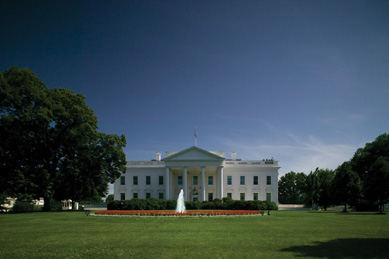
A full frontal shot of the White House on a clear, sunny day.
The White House is the third most photographed attraction in the United States, second to the Statue of Liberty and the Empire State Building. This figure, combined with the fact that the building is surrounded 360 degrees by a tall wrought-iron fence and guarded by government snipers, means that the barriers to making a ground-breaking photo might seem insurmountable! This shot approaches the dilemma with a sense of humor. You need both a very wide-angled lens and a bright day, because good depth of focus and a short enough shutter speed to avoid any hand tremors are essential. Stick your left hand (or your right, if you shoot with your left hand) with the folded $20 bill through the wrought iron fence (I assure you that the security guards will not bat an eyelash) and match up the actual and rendered sides of the White House. This is not as easy a task as it sounds— the scale of the image is minute, and the slightest error in match will ruin the effect. Now, steadily put your camera right up to the fence, frame your photograph, and shoot away. Take several, if not many, exposures to ensure that you capture a steady hand and a good matchup. This shot looks best if the sun is falling on the near side of the bill, so the afternoon is a better time to set up.

Focal length 24mm; ISO 100; aperture f/22; shutter speed 1/60; June 3:06 p.m.
This shot is a rear view of the White House and also involved a bit of logistic derring-do. Don’t fool yourself for a minute into thinking that the crowds at the rear side of the building will be more manageable than those at the front. They will not be! If you try to capture this shot from the sidewalk, you will not only be fighting for elbow room, but you will also have the surrounding iron fence in your line of sight. The only way to get this image is to be about four feet taller than all the other tourists (and to have a telephoto lens)—a feat easily accomplished by taking a quick jump up on the Zero Milestone that sits on the north edge of the Ellipse in President’s Park. Adjust your camera settings while you are standing on the sidewalk, because you don’t want to waste any time when you are standing atop the marker. A partner for this exercise is helpful, both for reconnaissance and for a helping hand with balance and clambering. Be brave, jump up, frame your shot, shoot away, and you will be back on the sidewalk before anyone has time to make a fuss.
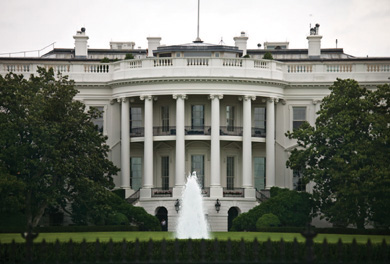
Focal length 230mm, ISO 100; aperture f/5.6; shutter speed 1/160; May 2:42 p.m.

A lone viewer on a cloudy spring day.
The formal and well-known address of the White House is 1600 Pennsylvania Avenue, but the street layout around the White House is somewhat chopped up by the park grounds surrounding the residence. The front entrance is best found by positioning yourself on G Street between 15th and 17th Streets, and the White House will be to the south. The closest Metro stations are Farragut West and McPherson, both on the Orange and Blue Lines.
The rear of the building can be reached from the front by following either East or West Executive Drive around the White House grounds. Alternatively, the rear can be approached from the National Mall by walking through the Ellipse, which is located to the north of the Washington Monument.
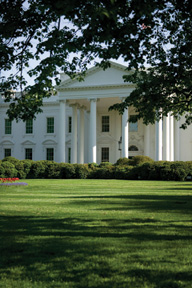
A view of the White House from under the trees.
A visitor to Union Station today will experience a well-preserved and thriving establishment. The building features lofty vaulted ceilings, and the marble stonework vies for attention with any of the capital’s main structures. However, behind this dignified façade lies a more turbulent past.
Completed in 1908, the building was constructed as a gateway to the capital and indeed was one of the earliest buildings designed to present a stately visage for the city. Its splendor was also reflective of the preeminence of rail travel at that time. When constructed for the cost of $125 million, it represented the largest building in terms of covered ground area in the United States.
Through several decades the station and enclosed shops and offices thrived, but with the decline in rail travel, driven by competition from the airlines, usage of Union Station fell away. The role of the station was revived by inclusion of a National Visitor Center in 1976, but this was poorly attended and closed in 1978. In 1981, after rain caused part of the roof to collapse, the poorly maintained building was sealed. After much debate around the role of the station, Congress took action, and a $160 million, three-year renovation plan was instituted. In 1988, the building was reopened in the magnificent state you see today. Exhibitions, cultural events, shops, and restaurants combine with train services to attract more than 30 million visitors every year. Union Station is back in the game!
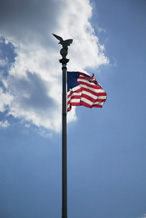
The flag staff outside of Union Station.
Union Station is one of the places in Washington, DC where I feel that including people in your photograph is an aid rather than a hindrance. The grand structure of the station functions as a solid and attractive backdrop juxtaposed against the hustle and bustle of Washington, DC commuters at rush hour. Travelers seem focused on their destination and tend to completely disregard the camera, conveying a sense of urban anonymity.
For this shot, I centered myself under the arches, outside and just to the right of the main entrance. You have to plant yourself relatively securely, since in their goal-oriented state, the crowds can get a little pushy. I set my camera on shutter priority mode and chose a shutter speed of 1/8 second so I could get a little bit of motion blur on the folks that were moving rapidly and close to me. The light stones reflect quite a great deal of light, and I was able to shoot with a small aperture, maintaining focus on both the foreground and background elements of the picture. A tunnel effect is created from the use of the wide angle lens, and the long passageway of arches diminishes rapidly into a forced perspective, where the people in the rear of the photo mill about in the human rat race!
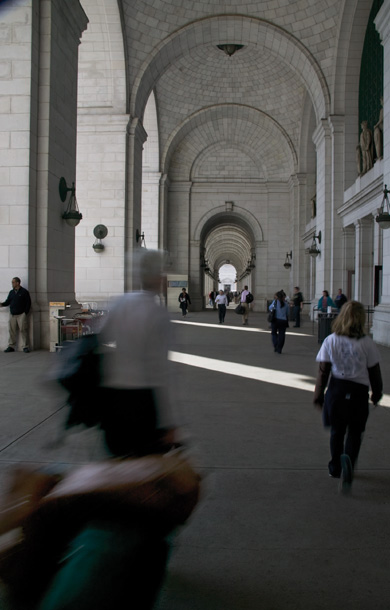
Focal length 28mm; ISO 100; aperture f/18; shutter speed 1/8 second; April 3:38 p.m.
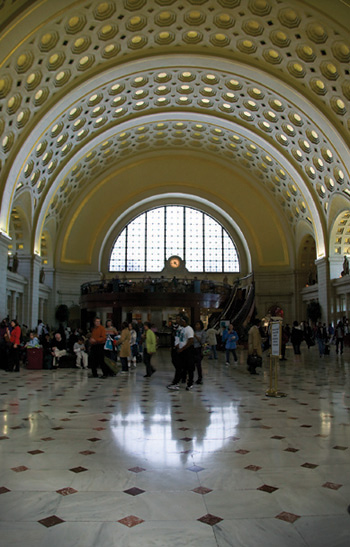
Focal length 28mm; ISO 200; aperture f/5.0; shutter 1/25 second; April 3:49 p.m.
Once again, the imposing architecture—this time of the station’s interior—makes an elegant background for the rail-weary travelers. The Rule of Thirds helps to make the composition of this picture solid and pleasing to the eye. This rule is a historically proven and traditional method of composition to ensure well laid out paintings, photographs—any art form, for that matter. The enormous vaulted arch of the ceiling and paned glass window falls into the top two-thirds of the frame, while the bottom third comprises the mosaic marble floor, with a horizontal line of people dividing the two elements.
Be sure to stand in the center between two columns when composing your picture and use a wide angle to be able to capture both the decorative floor and the beautiful golden ceiling. Since the inside of the station is somewhat dark, I increased my ISO to 200 in order to gain a stop of light, but I still had to be careful at 1/25 second shutter speed to hold my breath and not shake the camera during exposure. I love the way the diffused light from the large window illuminates the surface of the ceiling and makes each recess seem to have an inner golden glow of its own. The reflection of the curved window in the shiny marble floor breaks what could be a dull expanse and adds compositional interest.
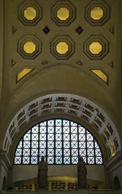
A detail of the arched golden ceiling.
How do you get to Union Station? Take a train, of course! Union Station is the arrival point for many visitors to Washington, DC, as it is served by Amtrak running up and down the East Coast and by local train services. If you are already in the city, then the Metro Red Line will bring you to the station. Union Station is located just to the north of the Capitol building, at the intersection of Delaware and Massachusetts Avenues. By the way, the station does feature a very reasonably priced food court with a wide variety of choices. This is located on the lower level below the ticket offices. Busy but convenient!
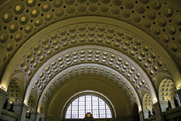
A horizontal composition of the ceiling in the main lobby.
The concept of the memorial was developed by a group of Vietnam veterans who wanted to acknowledge and recognize the service and sacrifice of all who had served in Vietnam. Construction of the memorial was funded from a variety of private sources after President Carter gave approval in 1980 for its installation.
The iconic memorial consists of two walls of black, polished granite, each 250 feet in length, angled obliquely to each other and set into the gentle slope. On each wall are painstakingly inscribed the names of the more than 58,000 dead and missing U.S. service members from the conflict.
One hundred fifty feet to the southwest of the apex of the wall stands the statue of Three Servicemen caught in action pose, apparently warily exiting a wooded setting. The bronze, larger-than-life statue was erected in 1984. The Memorial is completed with an integral, dedicated flag staff, which is grouped with the statue and provides an imposing entrance to the Memorial.
The Memorial is visited by millions each year, not least by many somber surviving Vietnam veterans.
This memorial offers up photographic concerns unlike those of any other piece of architecture, memorial, or statue that you will find in Washington, DC. In addition to its prodigious length, nearly impossible to capture in one frame, it is one of the few places where a human leave-behind is a boon rather than a disadvantage. The seemingly endless list of soldiers, combined with a rose left by one who came to honor and mourn, has substantially more emotional impact than the dark, cold granite on its own. I photographed the Memorial at an evening commemoration, and my electronic flash was indispensable. In this shot with the rose, both the fall off of the light from the flash and the use of a wide angled lens serve to exaggerate the sense of the infinite length of the list of soldiers’ names. I did not use a tripod here, but since there was no ambient light, my flash was the only light source, and I was able to keep the letters crisp and sharp with no evidence of camera movement.
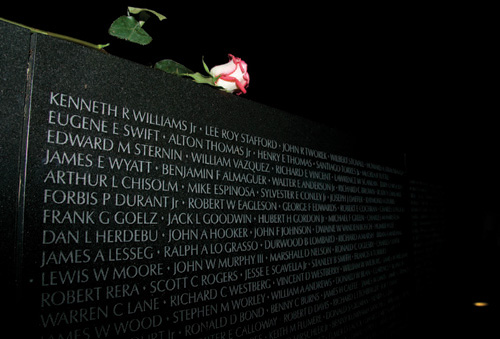
Focal length 28mm; ISO 100; aperture f/8.0; shutter speed 1 second; May 8:30 p.m.
This photograph of the flag standards at the Memorial was taken facing southwest, into the sun, which, because it was early April, was still somewhat low in the sky. Normally, this would be a lighting situation you would want to avoid, but I capitalized on the effect of shooting into the sun by turning the flare into a dramatic element of the photo.
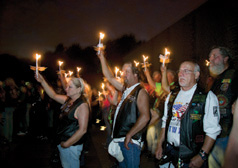
A crowd commemorating at a candlelight vigil.
I took quite a few exposures here, because it was a brisk and windy day, and the flags were moving turbulently. My exposure compensation was set at –1/3 to underexpose the shot 1/3 of a stop, keeping the rich blue of the sky. I wanted the light of the sun to be centered half behind the flag, so that the red, white, and blue fabric would be strongly backlit, yet still create a halo of flare above the flag. I positioned the flagpole on the left side of the frame so that when the flags were fully windblown, they would nicely fill the space of empty blue sky between the branches of the trees.
With patience (again, I must stress that patience is a huge factor in making good photographs) and multiple clicks of the shutter, I got exactly the shot I was looking for when a strong gust of wind came. The flags are extended with beautiful folds and curves, the acronyms POW-MIA are legible, and the flare created by looking directly into the sun frames the flags and creates a heroic and patriotic effect.

A visitor to the Memorial caught in an emotional moment.
The Memorial is located at the western end of the National Mall, close to the Lincoln Memorial in West Potomac Park. The Memorial is just to the north of the end of the Reflecting Pool. It may take a moment to locate the Wall, since it is partially set below ground level and can be overlooked. As an alternative approach, the Wall is located directly across Constitution Avenue from the National Academy of Sciences, 100 yards into the Park.
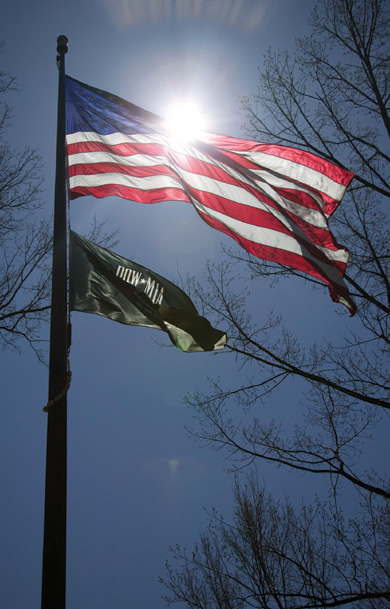
Focal length 44mm; ISO 100; aperture f/5.0; shutter speed 1/4000; April 12:28 p.m.
The capital city of the United States of America proudly bears the name of the leader of the revolution that gave independence to the country and who became its first President. At the center of the city, a monument to the man and his leadership stands majestically, towering above the surrounding structures. Views of the monument can be found from many vantage points throughout the city—indeed, few cities in the world can boast such a visible icon.
Yet for some time after construction began, the fate of the monument was uncertain. In 1854, the initiators of the original construction, the Washington National Monument Society, ran short of funds. Political wrangling intervened, and construction activities faltered. For 25 years the monument sat with only the lower one-third of the obelisk built, until the U.S. government stepped in, finally completing the structure in 1884. A legacy of this delay can be seen in the manner in which the upper and lower portions, which were built using stone from different quarries, have weathered differently, giving a slight mismatch of coloration.

The Monument framed by magnolias.
When completed, the monument stood as the world’s tallest structure, a title held until 1889, when the Eiffel Tower in Paris was finished. At 555½ feet, it remains the tallest stone structure in the world. Visitors to the Monument can take an elevator to the observation level and enjoy views of up to 30 miles of the surrounding countryside. It is often stated that no building in the District may be constructed that is taller than the Monument. In reality, construction height is limited by the Height of Buildings Act of 1910, which restricts construction to the equivalent of the width of the adjacent street plus 20 feet. Indirectly, this leaves the monument (and incidentally, the Capitol building as well) holding primacy over the majority of surrounding structures.
The Reflecting Pool situated between the Monument and the Lincoln Memorial allows a double view of the tribute to Washington’s great achievements.
Unlike the White House and other security-shrouded attractions, a creative and unusual shot of the Washington Monument is altogether possible. As you traipse around the Mall, keep your eyes and mind open, and you will invariably discover your own photographic angles and compositions, especially with all the trees, flowers, and decorations that you can include in your shot, both behind and in front of your placement of the Monument.
The plethora of American flags on display over Memorial Day weekend offered me the perfect chance to capture a patriotic and hopefully somewhat original image! The large flag was stretched in a frame at the top of a small hillock between the Reflecting Pool and the monument itself. I nearly laid down in the grass, so that I was actually looking up at my subjects, since I wanted to add a heroic quality to this image. The overcast sky acted as a light box for the flag and backlit it beautifully, making the colors vivid and bright. Following again the age-old Rule of Thirds, I allotted two-thirds of the composition to the flag and one-third to the Washington Monument. It is interesting how the vertical lines of the metal frame actually draw the divisions for you. Keep the monument vertical in all your photographs—it does not do well as a Tower of Pisa imitator.
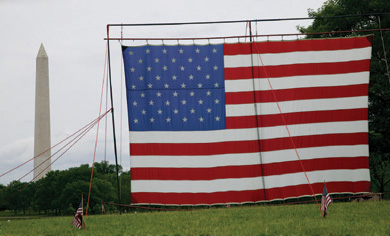
Focal length 80mm; ISO 100; aperture f/9.0; shutter speed 1/250; May 5:50 p.m.
Pierre L’Enfant’s classical layout of the Mall is perfectly referred to in this shot of the Washington Monument and the aptly named Reflecting Pool. If you squint your eyes, you could fool yourself into thinking that you are looking at a painting of the French Academy—balanced and controlled. I knelt very low on the edge of the Pool, just east of the Lincoln Memorial, and placed the monument in the upper center of my frame. Using the grid in the viewing screen of my camera, I was again very careful to keep the obelisk perfectly vertical, and thus the horizon line perpendicular to the edges of my frame.
A miscalculation here could ruin a lovely composition. By shooting from a low angle, I was able to keep the top of the monument’s reflection in the frame. This combined with the reflection of the trees and people on the walkway is what gives the picture its tight composition. Patience, that much sought-after virtue that often eludes me, allowed me to wait for the moment when the mallard was perfectly situated in the left third of the frame.
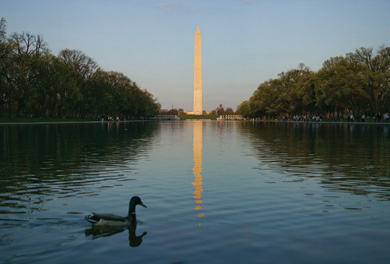
Focal length 55mm; ISO 100; aperture f/5.6; shutter speed 1/500; April 6:12 p.m.
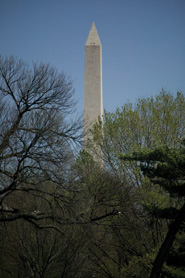
The Monument composed with trees in early spring.

The Monument at night.



